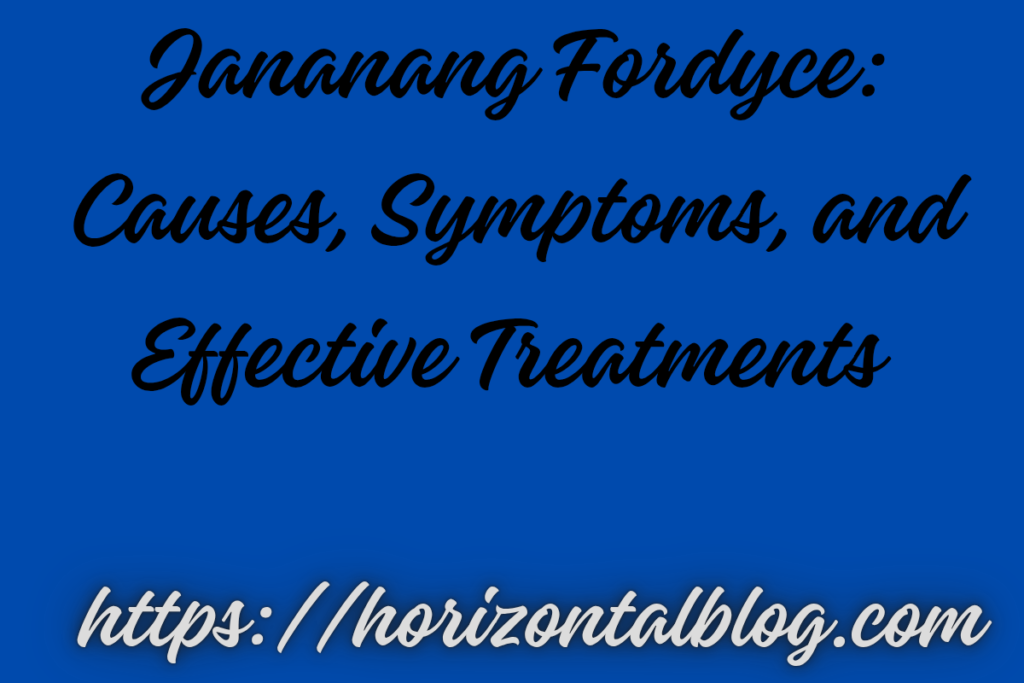Overview
If you’ve noticed small, pale or white bumps on your lips, genitals, or other areas of your body, you might be dealing with Jananang Fordyce spots. These are benign (non- cancerous) skin conditions that can appear in both men and women. While harmless, many people seek treatments due to aesthetic concerns.
In this comprehensive guide, we will discuss:
What Jananang Fordyce spots are
Their causes and symptoms
Home remedies and medical treatments
Prevention tips
FAQs to clear all your doubts
Let’s dive into everything you need to know about Jananang Fordyce spots and how to manage them effectively.
What Are Jananang Fordyce Spots?
Jananang Fordyce spots are small, painless, pale yellow or white bumps that appear on the skin. They are ectopic sebaceous glands, meaning oil glands that appear in areas where they normally wouldn’t be present.
These spots can be found in areas like:
Lips (particularly on the edges)
Inside the cheeks
Genital area (penis, scrotum, labia)
Upper lip and around the mouth
Though often mistaken for STDs or acne, Fordyce spots are completely harmless and not contagious.
Causes of Jananang Fordyce Spots
While the exact cause of Fordyce spots isn’t fully understood, they are considered a natural part of skin development. Some possible reasons include:
Overactive Sebaceous Glands – Excess oil production can make these glands more visible.
🔹1.Hormonal Changes – They often become more noticeable during puberty due to hormonal fluctuations.
🔹Genetics – Some people inherit a tendency to develop Fordyce spots.
🔹Aging – As the skin ages, oil glands may become more prominent.
These spots are NOT caused by infections, poor hygiene, or any external factors.
Symptoms and Identification of Jananang Fordyce Spots
Fordyce spots are easy to identify based on their distinct appearance. Here’s what to look for:
Small (1-3 mm) white, yellowish, or skin-colored bumps
Painless and non-itchy
Can appear singly or in cluster Do not contain pus or fluid (unlike pimples)
They may be more visible when the skin is stretched or under bright light.
Are Jananang Fordyce Spots Dangerous?
No, Fordyce spots are completely harmless. They do not lead to infections, cancer, or any health complications.
However, some people feel self-conscious about them, especially if they appear in visible areas like the lips or genital region. This leads many to seek removal options for cosmetic reasons.
Best Treatment Options for Jananang Fordyce Spots
Although Fordyce spots do not require treatment, various options are available for those who wish to reduce their appearance.
1. Home Remedies for Fordyce Spots
Natural remedies may help in minimizing the visibility of these spots:
Coconut Oil – Hydrates the skin and reduces oil buildup.
Apple Cider Vinegar – Has antibacterial properties; use diluted to prevent irritation.
Garlic – Contains anti-inflammatory properties that may help.
Jojoba Oil & Vitamin E – Nourishes the skin and reduces dryness.
Exfoliation with Lemon & Sugar – Helps remove excess oil and dead skin cells.
⚠ Caution: Home remedies take time and may not work for everyone. Always do a patch test before applying to sensitive areas.
2. Medical Treatments for Fordyce Spots
If home remedies don’t work, dermatologists offer several professional treatments:
Laser Treatment (CO2 or Pulsed Dye Laser) – One of the most effective methods to remove Fordyce spots.
Micro-Punch Surgery – A minimally invasive procedure to remove the spots.
Electrocautery (Heat Treatment) – Uses electrical currents to burn off the spots.
Topical Retinoids – Creams containing Vitamin A derivatives (like Tretinoin) can help reduce their appearance.
Cryotherapy (Freezing Therapy) – Involves freezing the spots with liquid nitrogen.
👉 Always consult a dermatologist before undergoing any procedure.
Can You Prevent Jananang Fordyce Spots?
There is no guaranteed way to prevent Fordyce spots since they are naturally occurring. However, some tips can help keep your skin healthy:
Maintain Good Skin Hygiene – Cleanse your skin regularly with mild soap.
Stay Hydrated – Drink plenty of water to keep skin moisturized.
Avoid Oily Skincare Products – Can reduce the visibility of oil glands.
Healthy Diet – Eat foods rich in Vitamin A, C, and E to promote skin health.
Don’t Pick or Scratch – This can lead to irritation or scarring.
Common Myths About Fordyce Spots
There are many misconceptions about these harmless skin spots. Let’s debunk some:
Fordyce spots are a type of STD. (False!) – They are not sexually transmitted or contagious.
They are caused by poor hygiene. (False!) – Hygiene has nothing to do with their occurrence.
Fordyce spots are a sign of skin disease. (False!) – They are completely benign.
They can be permanently removed with creams. (False!) – While creams may help reduce their appearance, complete removal often requires professional treatment.
Conclusion
Jananang Fordyce spots are a completely natural and harmless skin condition. While they may be aesthetically unpleasing to some, they do not pose any health risks.
If you feel self-conscious about them, there are multiple treatment options available. However, understanding that they are a normal part of your body can help ease concerns.
Frequently Asked Questions (FAQs)
1. Are Fordyce spots painful?
No, Fordyce spots are completely painless and do not cause discomfort.
2. Do Fordyce spots go away on their own?
Sometimes they become less noticeable over time, but they usually don’t disappear completely without treatment.
3. Can Fordyce spots spread?
No, they do not spread like a rash or infection. They remain in the same areas where they naturally appear.
4. Is it safe to remove Fordyce spots at home?
No, attempting to remove them yourself can cause scarring, infection, or irritation. Always seek professional advice if you wish to remove them.
5. Are Fordyce spots more common in men or women?
They are more commonly observed in men, but women can also develop them, especially on the labia.
6. Can Fordyce spots be a sign of an underlying health problem?
No, they are completely normal and not linked to any health issues.
7. Does stress cause Fordyce spots?
No, stress does not cause them, but excessive stress can worsen skin conditions in general.
8. Are Fordyce spots a form of acne?
No, unlike acne, Fordyce spots are not caused by bacteria or clogged pores.



